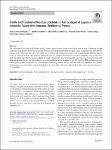Mostrar el registro sencillo del ítem
Profile and content of residual alkaloids in ten ecotypes of Lupinus mutabilis Sweet after aqueous debittering process
| dc.contributor.author | Cortés-Avendaño, Paola | |
| dc.contributor.author | Tarvainen, Marko | |
| dc.contributor.author | Jukka-Pekka, Suomela | |
| dc.contributor.author | Glorio-Paulet, Patricia | |
| dc.contributor.author | Yang, Baoru | |
| dc.contributor.author | Repo-Carrasco-Valencia, Ritva | |
| dc.date.accessioned | 2020-05-13T22:45:43Z | |
| dc.date.available | 2020-05-13T22:45:43Z | |
| dc.date.issued | 2020 | |
| dc.identifier.citation | Paola Cortés-Avendaño, Paola; Tarvainen, Marko;Jukka-Pekka,Suomela; Glorio-Paulet1, Patricia ; Yang, Baoru y Repo-Carrasco-Valencia, Ritva. (2020). Profile and Content of Residual Alkaloids in Ten Ecotypes of Lupinus mutabilis Sweet after Aqueous Debittering Process. https://doi.org/10.1007/s11130-020-00799-y | es_PE |
| dc.identifier.issn | 1573-9104 | |
| dc.identifier.uri | https://hdl.handle.net/20.500.12996/4361 | |
| dc.description | Universidad Nacional Agraria La Molina. Facultad de Industrias Alimentarias | es_PE |
| dc.description.abstract | The evaluation of the level of alkaloids in edible Lupinus species is crucial from a food safety point of view. Debittering of lupin seeds has a long history; however, the control of the level of alkaloids after processing the seeds is typically only evaluated by changes in the bitter taste. The aim of this study was to evaluate the profile and residual levels of quinolizidine alkaloids (QA) in (Lupinus mutabilis Sweet) after aqueous debittering process. Samples from 10 ecotypes from different areas of Peru were analyzed before and after the process. Based on results obtained by gas chromatography and mass spectrometry, from eight alkaloids identified before the debittering process, only small amounts of lupanine (avg. 0.0012 g/100 g DM) and sparteine (avg. 0.0014 g/100 g DM) remained in the seeds after the debittering process, and no other alkaloids were identified. The aqueous debittering process reduced the content of alkaloids to levels far below the maximal level allowed by international regulations (≤ 0.2 g/kg DM). | en_US |
| dc.format | application/pdf | en_US |
| dc.language.iso | eng | en_US |
| dc.publisher | Springer | es_PE |
| dc.relation.uri | https://link.springer.com/article/10.1007/s11130-020-00799-y | es_PE |
| dc.rights | info:eu-repo/semantics/openAccess | en_US |
| dc.rights.uri | https://creativecommons.org/licenses/by-nc-nd/4.0/ | * |
| dc.subject | Lupinus mutabilis | es_PE |
| dc.subject | Ecotipos | es_PE |
| dc.subject | Granos | es_PE |
| dc.subject | Secado | es_PE |
| dc.subject | Deshidratación acuosa | es_PE |
| dc.subject | Rendimiento | es_PE |
| dc.subject | Procesamiento | es_PE |
| dc.subject | Contenido proteico | es_PE |
| dc.subject | Propiedades fisicoquímicas | es_PE |
| dc.subject | Análisis organoléptico | es_PE |
| dc.subject | Composición química | es_PE |
| dc.subject | Evaluación | es_PE |
| dc.subject | Perú | es_PE |
| dc.subject | Tarwi | es_PE |
| dc.subject | Chocho | es_PE |
| dc.title | Profile and content of residual alkaloids in ten ecotypes of Lupinus mutabilis Sweet after aqueous debittering process | en_US |
| dc.type | info:eu-repo/semantics/article | en_US |
| dc.identifier.doi | https://doi.org/10.1007/s11130-020-00799-y | es_PE |
| dc.subject.ocde | https://purl.org/pe-repo/ocde/ford#2.11.01 | es_PE |
| dc.type.version | info:eu-repo/semantics/publishedVersion | en_US |
Ficheros en el ítem
Este ítem aparece en la(s) siguiente(s) colección(ones)
-
CIINCA [7]
Centro de Investigacion e Innovación en Productos Derivados de Cultivos Andinos



